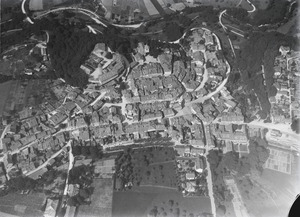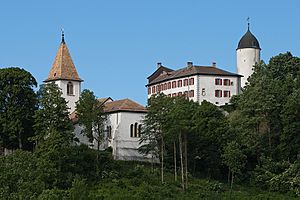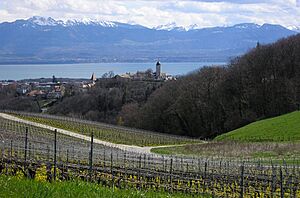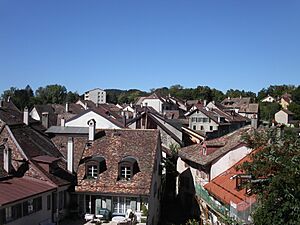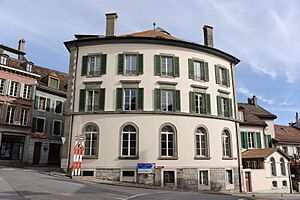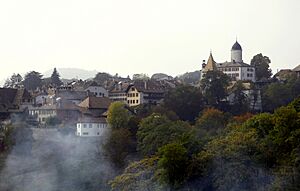Aubonne facts for kids
Quick facts for kids
Aubonne
|
||
|---|---|---|
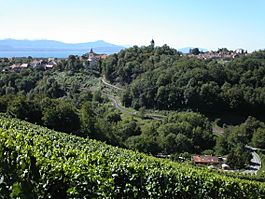
Aubonne
|
||
|
||
| Country | Switzerland | |
| Canton | Vaud | |
| District | Morges | |
| Area | ||
| • Total | 14.36 km2 (5.54 sq mi) | |
| Elevation | 508 m (1,667 ft) | |
| Population
(Dec 2020 )
|
||
| • Total | 3,235 | |
| • Density | 225.28/km2 (583.47/sq mi) | |
| Demonym(s) | Les Aubonnois | |
| Postal code |
1170
|
|
| Localities | Trévelin, Bougy-Saint-Martin | |
| Surrounded by | Allaman, Féchy, Pizy, Saint-Livres, Lavigny, Etoy | |
Aubonne is a town in the canton of Vaud in Switzerland. It is part of the Morges area. In 2011, the nearby town of Pizy joined Aubonne. Then, on January 1, 2021, Montherod also became part of Aubonne.
Contents
History of Aubonne
People have lived in the Aubonne area for a very long time. The oldest signs of life are from the Bronze Age, which was thousands of years ago. Later, during Roman times, there were villas here. We also found graves from the early Middle Ages.
The first time Aubonne was written about was in 1177. It was called Albona back then. In the early 1200s, a strong wall was built around the town to protect it. In 1255, the town was sold to Count Peter II of Savoy. He let the Thoire-Villars family rule the town.
Aubonne was a very important town on the north side of Lake Geneva until the late 1400s. Since the 1200s, it had weekly markets. From 1487, it also had special three-day markets twice a year.
In 1393, the Count of Greyerz bought Aubonne. Because he was friends with the Eidgenossen (the old Swiss confederates), Aubonne was safe during the Burgundian Wars in 1476. When the canton of Vaud was taken over by Bern in 1536, Aubonne came under Bern's rule. However, it still belonged to the Count of Greyerz until 1553.
In 1670, a French traveler named Jean-Baptiste Tavernier bought the city. Later, in 1685, Henri Duquesne bought it. He then sold it back to Bern in 1701. From 1798 to 1803, Aubonne was part of the canton of Léman. This canton later became the canton of Vaud, thanks to Napoleon. Aubonne was the main town of its district from 1803 until 2006.
On December 5, 2017, Michael I of Romania, who used to be the King of Romania, passed away at his home in Aubonne.
Geography of Aubonne
Aubonne is located about 508 meters (1,667 feet) above sea level. It is about 19 kilometers (12 miles) west of Lausanne. The town is in the valley of the Aubonne river. It sits on the edge of the Jura foothills, about 130 meters (427 feet) higher than Lake Geneva.
The highest point in Aubonne is about 643 meters (2,109 feet) high.
The small villages of Trévelin and Bougy-Saint-Martin are also part of Aubonne. The towns nearby include Allaman, Féchy, Pizy, Montherod, Saint-Livres, Lavigny, and Etoy.
Aubonne covers an area of about 6.87 square kilometers (2.65 square miles). A large part of this land, about 63.3%, is used for farming. Forests cover about 14.1% of the area. Buildings and roads make up about 22.1% of the land.
Aubonne was the main town of the Aubonne District until August 31, 2006. After that, it became part of the new Morges district.
Aubonne's Coat of Arms
The blazon (description) of Aubonne's coat of arms is simple: it is divided into two halves, one red and one gold.
People of Aubonne
Aubonne has a population of about 2,650 people. In 2008, about 24.7% of the people living here were from other countries. Over ten years (1999–2009), the population grew by about 5.9%.
Most people in Aubonne (about 84%) speak French. German is the second most common language (about 5.2%), followed by Portuguese (about 3.6%).
About 24.2% of the people living in Aubonne in 2000 were also born there. Another 32.8% were born in the same canton (Vaud). About 21.9% were born outside of Switzerland.
The chart below shows how Aubonne's population has changed over time:

Important Heritage Sites
Several places in Aubonne are very important to Swiss history and culture. These are called heritage sites of national significance. They include:
- The old Federal Powder Mill
- Aubonne Castle
- The City Hall and grenette (a type of grain market)
- The D'Aspre House with its Orangery (a special greenhouse for orange trees)
- The Manoir et manège (a manor house and riding school)
The whole town of Aubonne and the Federal Powder Mill are also part of the Inventory of Swiss Heritage Sites.
Tourism in Aubonne
Aubonne has some interesting places to visit. A wood museum opened here in 1967. Also, the first arboretum (a place where many different kinds of trees are grown) in the canton of Vaud was started in Aubonne in 1963. It covers about 200 hectares (494 acres) and has both local and foreign trees.
Aubonne's Economy
For a long time, Aubonne was mainly a farming town. Today, farming is not as important. However, the region still produces wine.
Aubonne did not have a railway line in the 1800s, so factories came later. The first factory, which made gunpowder, was built in 1853. In the 1900s, other businesses came, like those making precision machines, furniture, and medicines.
Today, most jobs in Aubonne are in the service sector. This means jobs like retail, healthcare, and other services. In 2010, the unemployment rate in Aubonne was 3%.
Religion in Aubonne
Based on a 2000 survey, about 29.6% of people in Aubonne were Roman Catholic. About 42.2% belonged to the Swiss Reformed Church. There were also smaller numbers of people who were Orthodox Christian, other Christians, Jewish, or Islamic. Some people were Buddhist or Hindu. About 15.1% of the population did not belong to any church.
Education in Aubonne
In Aubonne, many people have a good education. About 32.8% of the population have finished high school. About 20.3% have gone on to higher education, like a university.
In the 2009/2010 school year, there were 341 students in Aubonne's schools. The canton of Vaud offers two years of optional pre-school. Primary school lasts for four years, and lower secondary school lasts for six years.
Aubonne also has a private international school called La Côte International School.
Transportation
Aubonne is located where two important highways meet. One highway goes between Rolle and Cossonay, and the other goes between Allaman and Gimel. The entrance to the A1 motorway, a major highway, is only about 2 kilometers (1.2 miles) from the town center. It opened in 1964.
The train station for the Lausanne-Geneva railway opened in 1858. It is just outside Aubonne, in Allaman. From 1896 to 1952, there was an electric tram that ran from Allaman to Aubonne. Today, buses connect Aubonne to Allaman, Gimel, Rolle, and Etoy.
Notable People from Aubonne
- Jean-Baptiste Tavernier (1605–1689): A French gem merchant and traveler from the 1600s. He owned Aubonne from 1670 to 1685.
- Alexandre Yersin (1863–1943): A Swiss and French doctor and scientist. He was born in Aubonne and discovered the germ that causes the plague.
- Charles Ferdinand Ramuz (1878–1947): A famous Swiss writer who wrote in French. He studied in Aubonne.
- Georges de Mestral (1907–1990): A Swiss engineer who invented the hook-and-loop fastener, known as Velcro. He lived in Aubonne.
- Michael I of Romania (1921–2017): The last King of Romania. He had a home in Aubonne and passed away there.
- Sibylle Blanc (born 1974): A Swiss actress and director who speaks French. She was born in Aubonne.
See also
 In Spanish: Aubonne (Vaud) para niños
In Spanish: Aubonne (Vaud) para niños





